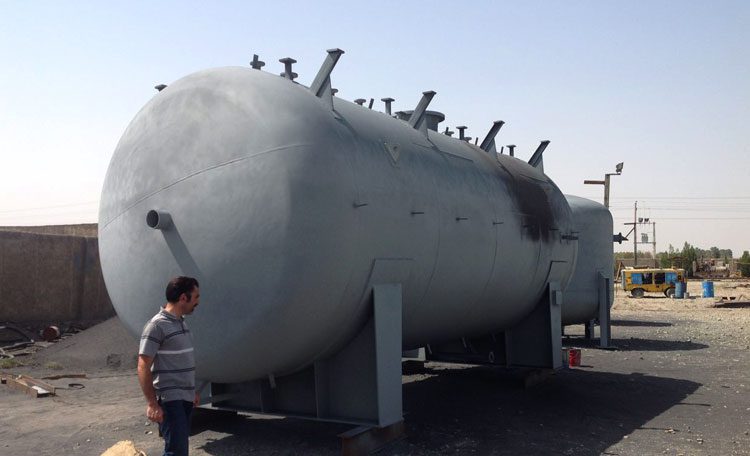Metal and polyethylene acid storage tank is one of the most essential equipments for storage and transportation of acidic materials, which should be designed and produced in a completely standard manner due to the corrosivity of these materials. Material used for the body, capacity and overall shape of the tank are among the items to be considered in the process of design, production and construction of sulfuric acid storage tank and hydrochloric acid tank and other acidic materials. Seven Industrial Group is a manufacturer of material storage tank, which offers tanks with metal bodies for this purpose to increase its life and efficiency. In the following, we will provide a comprehensive guide including the types of acid storage tanks, important principles and standards in the design, production and manufacture of hydrochloric acid and sulfuric acid tanks and other acidic materials, the price of the acid storage tank.
What is an acid storage tank?
Acidic materials are widely used in various industries and in many cases need to be transported to different factories or stored in large quantities in industrial environments. Due to the very high risk of these substances coming into contact with the human body and their high corrosive power, it is necessary to keep these chemicals in tanks that are completely resistant. Sulfuric acid storage tank and hydrochloric acid tank are two common types of acid storage tanks that are produced in different models. Acid storage tank is a tank made of corrosion-resistant metal or polyethylene material, which provides the ability to retention and store these materials and transport them over long distances in a completely safe manner. These tanks are designed and produced in the form of tanks installed in a fixed place or portable tankers that are used in different conditions.
Types of acid storage tank
Acid storage tank is widely used in various industries and according to the type of acidic materials, their density, amount of acidic materials and environmental conditions, the tank is designed and produced in various types. Based on the general shape of acid storage tanks, they can be divided into the following groups:
· Horizontal acid storage tank
· Vertical acid storage tank
· Funnel acid storage tank
· Cubic acid storage tank
Each of the above models are very different in terms of capacity and capacity. For example, horizontal storage tanks with a capacity of several hundred thousand liters can be designed and built, and in contrast, funnel bottom storage tanks can be produced up to several tens of thousands of liters. In addition to the division of metal acid storage tanks based on their appearance, according to the type of acidic material and the density of each, changes are made in the design of the acid storage tank. Accordingly, the common and widely used types of these tanks can be divided as follows:
Sulfuric acid storage tank
One of the most important and widely used acidic materials in the industry is sulfuric acid, which due to its high corrosive power, great care must be taken in choosing the material of the storage tank body. Due to the high corrosion of these materials and their calorific value in contact with water, the best option for making a sulfuric acid storage tank is stainless steel metal bodies that have high resistance to corrosion. It should be noted that due to the appearance of these resources, certain standards should be considered during design and construction. For example, the ASME standard is observed in the design of horizontal acid storage tanks and is defined for API standard 650 standard vertical tanks. A very important issue in the construction of sulfuric acid storage tank is that polyethylene and plastic bodies do not have good resistance to these materials and it is better to choose metal tanks for this purpose.
Hydrochloric acid storage tank
Another very widely used acidic material in various industries such as textiles and plastics is hydrochloric acid, which has a very high corrosive power. In addition to carefully choosing the right body material for these acid storage sources, it is necessary to pay attention to the evaporation of these materials. For this purpose, in the construction of hydrochloric acid storage tank, an outlet ducts for gases produced from acidic materials are considered so that their accumulation in the tank does not damage the body.
Nitric acid storage tank
Unlike other acidic materials that can be stored in a plastic tank, nitric acid should only be stored if the body is metal and steel. Otherwise, it will quickly cause corrosion in the tank body and create holes and cracks in it.
Steel acid tank design
Due to the very high corrosive power of most of the widely used acidic materials in industry such as sulfuric, hydrochloric and nitric acids, it is necessary to pay attention to several important issues in the design of the acid tank. In general, there are several important issues in the design of steel acid tank for storage of strong acidic materials, which are:
Appearance of stainless steel tank
As mentioned, steel acid storage tanks are designed and manufactured in different types of horizontal, vertical, funnel and cubic, for each of which international standards have been defined. Therefore, according to the capacity of the tank, the place of installation and maintenance of the tank, it is necessary to choose the appropriate appearance for it and design according to the standards.
Concentration of acidic substances
Another very important factor in the design of a metal acid tank is the concentration of acidic substances. By considering the concentration of these materials, the required thickness for the tank body and its material can be selected
Chemical properties of acidic substances
In addition to the corrosive power of acidic materials, flammability, heating and other characteristics of each acidic material in the tank must be considered. For example, if the acidic material is capable of producing steam and heat, it must be considered in the gas outlet duct in the tank body.
Construction of Acid storage tank
Seven Industrial Group is one of the largest manufacturers of chemical storage tanks, which carries out the process of designing and producing acid tanks according to international standards. Due to the long life and higher efficiency of sheet metal, Seven Industrial Group has selected strong and durable metal bodies for the construction of acid storage tank. All products of this collection are produced according to the desired environmental conditions, concentration and type of acidic substances and the amount of acid in each tank. To know the features of each of the steel acid storage tanks produced by this group, the experts of Seven Industrial Group are ready to provide the necessary advice before purchasing the acid storage tank.
Acid storage tank price
The price of an acid storage tank depends on various factors, and therefore there is a great variety in the price of these tanks. Body material, thickness of sheets used in the body, tank capacity, appearance (horizontal, vertical, funnel and cube) and fittings and ancillary features for the tank are among the factors that determine the price of the acid storage tank. It should also be noted that depending on whether the storage tank is non-buried or the storage tank is buried, the price of the tank will change. To inquire about the price of sulfuric acid storage tank and other acidic materials, you can use the communication channels mentioned at the bottom of the page.
Advantages of metal acid storage tank
In addition to acidic metal tanks, polyethylene bodies can be used to store some acidic materials. But in general, for several important reasons, the metal tank of acid is more used and in industrial environments can be used safely, which are:
· Very high corrosion resistance
· No chemical reaction with acidic substances
· Long life and more performance
· Very high impact strength
· Easy and completely safe movement over long distances
· Leak-proof body due to high resistance to corrosive materials
· Can be designed and manufactured in various horizontal, vertical, funnel and cube shapes






